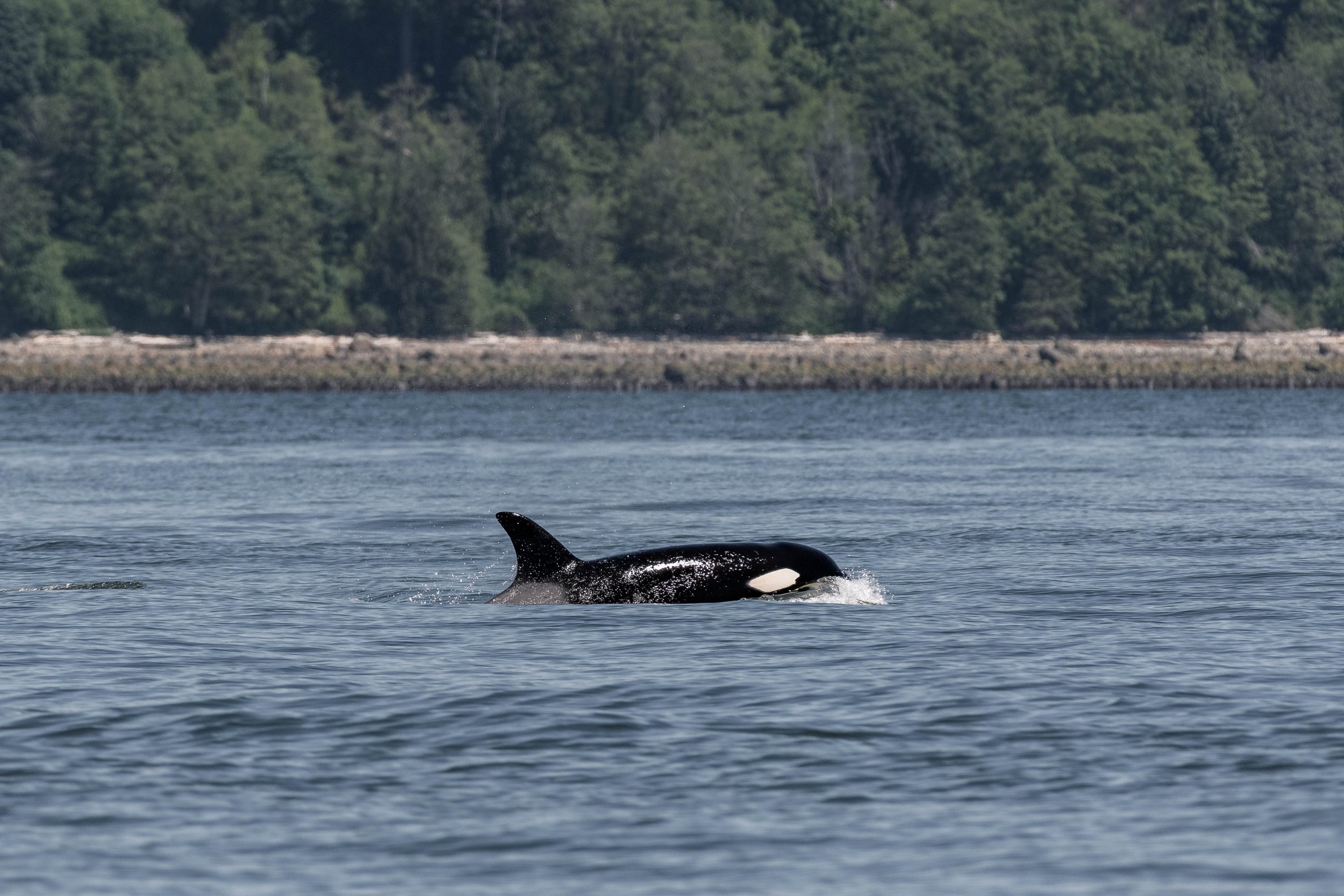May 28, 2025 - Double species all the way across!
Another beautiful, sunny day greeted us as we prepared for a day of whale watching. The wildlife sightings began even before our boats had left the dock, with a little river otter cleaning itself just one dock over. It quickly distracted both the naturalists and guests as they made their way to the boats.
These clever little otters often trick people by spending time in saltwater environments, making observers believe they’re seeing a sea otter. Fortunately, there are a few easy ways to tell them apart:
Consistent brown coloration: River otters are entirely reddish-brown, while sea otters have a distinct white face that lightens with age.
Land mobility: River otters can run easily on land, while sea otters—being almost entirely aquatic—are awkward and clumsy out of the water.
Swimming posture: If the otter is swimming on its front, it’s a river otter. Sea otters typically swim on their backs.
Not letting the otter distract us for too long, we headed out into the Strait of Georgia, making our way toward the far side of the Strait after hearing reports of a group of orca nearby. These whales were quite spread out, but thanks to photo identification, both onboard and later in the office, we were able to confirm the individuals present.
T023C Cindy ♀ (1990)
T023C3 Durban ♀ (2009)
T023C4 Bunzie ♂ (2013)
T023C5 Grym ♀ (2018)
T023C6 Cascade ♂ (2023)
T090 Eagle ♀ (1980)
T090B Piglet ♂ (2006)
T090C Tigger ♀ (2010)
T090D Kanga ♀ (2017)
When orcas are this spread out, a few things might be happening. Often, they separate in search of prey. In larger groups, they can lose the element of surprise, as it’s much easier for potential prey to detect 9 whales compared to 4 or 5. Even when spread out, they remain in vocal contact, so if one group finds prey, the others can quickly converge for the hunt and share the meal.
It’s also possible that they were splitting up to socialize. The groupings we observed seemed to support this idea: the boys (Piglet and Bunzie) stayed close together, Tigger was travelling with Durban (both similarly aged females), and Cindy was with her calf. These smaller groups likely have strong social bonds, making this a perfect time for them to strengthen those relationships and—who knows—swap stories.
Most likely, it was a combination of both hunting strategy and socializing—or perhaps even something entirely different influencing the group’s behaviour. Either way, it was a delight to watch as these groups mingled and travelled together.
After our time with the orcas, we continued our search and soon encountered a pair of humpback whales near Gabriola Island. At first, they appeared to be feeding. We observed them surfacing for a few breaths, followed by dives lasting around six minutes, likely chasing prey beneath the surface. One of the whales lifted its tail while diving, making for an easy identification: Maite (BCX0565calf2022). The other whale didn’t show its fluke, but we were able to identify it as Specter (BCX1333calf2023)! Using its dorsal fin.
The two whales were closely associated, staying near one another and synchronizing their movements. Humpbacks are usually quite predictable in their dive patterns, but while we watched, their behaviour shifted briefly. They became more playful and curious, spending less time submerged. This behaviour lasted only a few minutes before they returned to focused feeding, and we left them to it, beginning our journey back to Nanaimo.
It was a wonderful day filled with wildlife encounters, and our onboard Marine Naturalists, Aly Kohlman, Hayleigh Hilbert, and Val Watson, captured some incredible photos throughout the trip, which you can enjoy below!
A river otter after a swim! Photo by Aly Kohlman.
T023C4 Bunzie. Photo by Aly Kohlman.
T023C6 Cascade. Photo by Aly Kohlman.
T090 Eagle. Photo by Aly Kohlman.
T023C6 Cascade Followed by T090 Eagle with another surfacing behind them. Photo by Aly Kohlman.
T090 Eagle followed by T090D Kanga. Photo by Aly Kohlman.
T090B Piglet. Photo by Aly Kohlman.
T023C3 Durban. Photo by Aly Kohlman.
T090C Tigger. Photo by Aly Kohlman.
T090C Tigger. Photo by Aly Kohlman.
T090B Piglet with T023C4 Bunzie in tow. Photo by Val Watson.
T023C6 Cascade. Photo by Val Watson.
T090B Piglet. Photo by Hayleigh Hilbert.
Specter with Maite following. Photo by Val Watson.
Specter going for a dive. Photo by Val Watson.
Specter (right) and Maite (left) side by side. Photo by Hayleigh Hilbert.
Specter’s dorsal fin. Photo by Hayleigh Hilbert.
The front of Maite’s tail. Photo by Aly Kohlman.
Maite’s fluke with a BC ferry in the background. Photo by Hayleigh Hilbert.
Can you spot the stiff hair on the tubercles? Photo by Aly Kohlman.
A Brown Pelican at the White Islets! Photo by Val Watson.
Harbour seal cuddle puddle. Photo by Aly Kohlman.
A Steller Sea Lion posing in the sun. Photo by Aly Kohlman.
A very fuzzy Steller snoozing. Photo by Aly Kohlman.
Just contemplating life. Photo by Aly Kohlman.
Look at that mane! This is where the name Sea Lion comes from. Photo by Aly Kohlman.
Multiple nappers on the rocks. Photo by Aly Kohlman.
A surf scoter. Photo by Hayleigh Hilbert.
Cascadia with the coastal mountains! Photo by Val Watson.





























